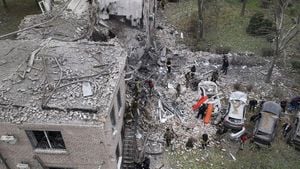Winter is looming, bringing with it the promise of chilly days and, unfortunately, the potential for overwhelming pressures on the UK's National Health Service (NHS). Leading emergency doctors are sounding the alarm bells over patient care at accident and emergency (A&E) departments, which are bracing for another challenging winter as conditions worsen.
A new survey from the Royal College of Emergency Medicine (RCEM) has put the situation under the microscope, and the results are concerning. Conducted earlier this month, the survey included responses from 83 emergency medics across hospitals nationally, yielding staggering findings: 83% reported patients being treated in the corridors, and 51% indicated care was being provided to patients waiting outside the department, often confined to ambulances.
Dr. Adrian Boyle, the President of the Royal College of Emergency Medicine, did not mince words. He expressed grave concerns about patient safety, emphasizing, “This is a stark warning from those on the front line. Clinicians are worried and patients are unsafe.” His words echo the widespread anxiety felt among healthcare professionals who see firsthand the conditions deteriorate as colder weather approaches.
Indeed, the picture painted by the survey is grim. A staggering 94% of the surveyed medics felt patients were suffering harm due to these conditions, and nearly nine out of ten—87%—voiced doubts about their departments’ ability to manage the influx of patients this winter. Alarmingly, 41% reported feeling less prepared for the cold months compared to the previous year. Only 11% felt they had improved their readiness.
Health officials admit the winter months might spell trouble again. Performance metrics indicate significant struggles within the emergency departments—ambulance response times and handling of emergency cases are spotty at best. The latest data reveals nearly 50,000 people waited more than 12 hours to be admitted to A&E, marking this as one of the three highest monthly figures since records began over a decade ago.
Much of the strain on services is attributed to the existing “corridor care” crisis. This term, which often feels like hospital jargon, refers to patients being treated on trolleys or chairs, leading to dehumanizing experiences. Dr. Boyle highlighted how patients, often old and vulnerable, suffer the indignity of such care, remarking, “Each one someone’s mum, dad, gran, or grandad, condemned to degrading treatment.”
Responses from health service officials paint a broader picture of systemic issues facing the NHS, issues like chronic underfunding and inadequate social care. The patients stuck awaiting discharge—averaging over 12,000 daily—exemplify the bottlenecks created when hospital beds are occupied unnecessarily. Delayed discharges come at the expense of patients needing urgent care, leading to overcrowding and compromising care quality.
Dr. Nick Murch, president of the Society for Acute Medicine, echoed these sentiments, sharing the pervasive sentiment of unease among emergency staff. With scant relief anticipated, he noted, “Staff had trepidation and concern about the coming months,” as they brace for the inevitable rise in patient numbers.
The reality is stark: pressures across the board are palpable, with A&E departments increasingly becoming points of crisis rather than care. Emergency departments are experiencing surging attendance, and ambulance services are grappling with slow response times; on average, the wait for response times to the most urgent calls exceeds national targets significantly. Reports show response times averaged over eight minutes for life-threatening emergencies like heart attacks and strokes.
Recent statistics have shown ambulance crews also lagging behind expected response times, particularly for emergency calls. Last month saw them taking over 42 minutes—twice the expected time—to respond to certain urgent cases. Health officials stress these delays can have catastrophic results.
The government has faced scrutiny for its failure to provide sufficient resources to tackle the impending winter crisis. Dr. Boyle criticized the lack of acknowledgment and funding from officials to tackle the substantial issues affecting patient care—even as frontline staff continue to push through under intense pressures. “There was nothing to address or ease the pressures,” he lamented, pointing to key budget decisions prior to winter which didn't meet the urgent needs of A&E resources.
This underfunding situation has raised voices from various commentators, describing the circumstances as not only troubling but unsustainable. A “corridor care disaster,” some have dubbed it, positions both medical professionals and patients at risk, intensifying the already heavy burden on staff who work tirelessly within these constraints.
Despite the dire circumstances, health officials continue to insist they are preparing for the challenging months to come. An NHS England spokesperson mentioned strategies being put forth to address the increase in demand. They highlighted efforts to set up system control centers and roll out new bacterial vaccine programs alongside flu vaccines, as part of the NHS’s response to the looming winter crisis.
Further complicity arises from the reality outside of hospital settings. Limited options for social care have exacerbated downstream issues dramatically—fewer upward transitions from waiting rooms and exit points have created bottlenecks. The integration of social care has not kept pace with NHS projections for optimal patient flow.
Critics remain vocal about how the situation reflects poorly on national health policies, which have failed to adapt to the rising challenges of modern healthcare needs. They argue sustained changes are necessary to avoid repeating past mistakes, especially as winter pressures mount once again.
The road forward may seem fraught with obstacles, but some health leaders believe there is still hope. The Department of Health and Social Care acknowledged the challenges but expressed determination to work with NHS trusts to bolster preparedness, emphasizing the need for long-term investment plans to build resilience within the system.
“We understand the significant concerns held by hardworking staff,” stated the department's spokesperson, fortifying the notion of creating pathways to alleviate the annual winter crisis. There has been mention of recent financial boosts amounting to £26 billion aimed at creating more sustainable long-term solutions, as officials envision reinvigorated NHS infrastructure capable of delivering services throughout the year, beyond seasonal fluctuations.
Yet for many on the ground, solutions seem out of reach. A heavy reliance on the existing workforce, which is stretched thin, and promises of funding without immediate tangible relief, have left frontline providers feeling overlooked. They hope awareness will spur momentum for actionable change before the winter intensifies the challenges they face.
This situation undeniably calls for urgent interventions, especially as winter draws near, alongside rising patient numbers. The prospect of more patients arriving at emergency rooms is not purely theoretical—it’s looming ever closer. Unless significant changes, both immediate and foundational, are set forth, healthcare professionals fear they may be forced to confront yet another winter of crisis.



